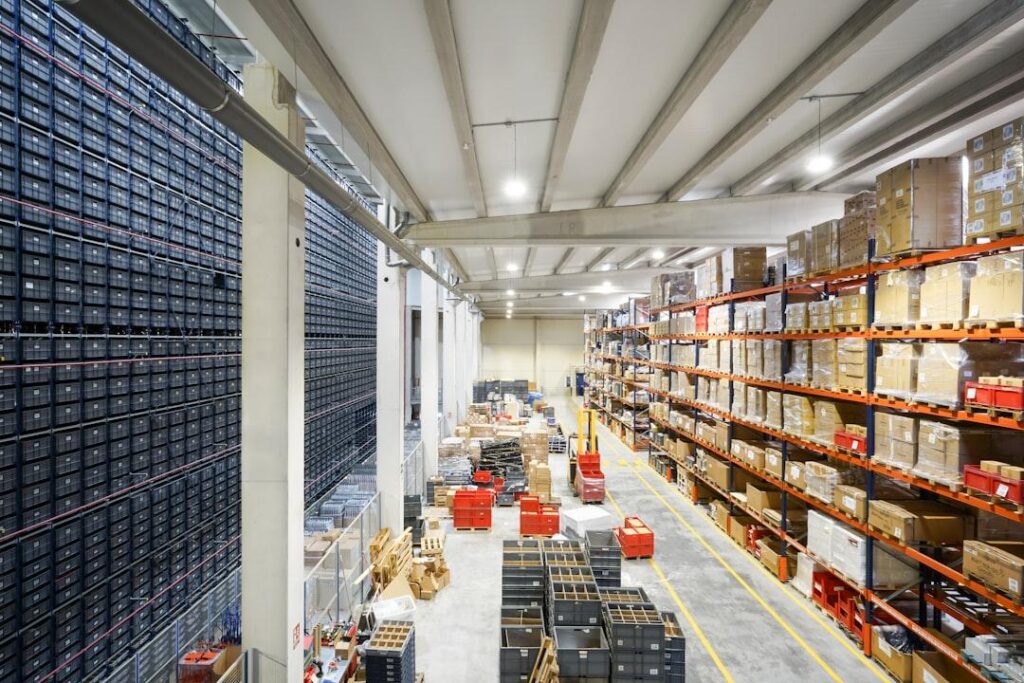Running a warehouse without a good picking method is like trying to grocery shop with three different lists and no cart: technically possible, but painfully inefficient. Wave picking solves that problem by grouping orders into “waves” based on factors such as product type, shipping deadlines, or individual order priority. Instead of handling orders as they arrive, workers pick multiple orders at once in a controlled sequence.
This approach can cut down on travel time, reduce bottlenecks, and make better use of staff schedules. On the other hand, keeping those waves flowing smoothly takes careful planning and the right tools. For some operations, the setup and coordination might outweigh the benefits.
By understanding best practices and how the wave picking method compares to others, what makes it work, and how to adapt it to your warehouse operations, you can decide whether a wave picking strategy fits your order fulfillment needs.
Comparing Picking Methods
Every warehouse has its own rhythm, and the picking process sets the tempo. Some methods work well for high-volume e-commerce, while others best suit small or specialized operations. We’ll show you how wave picking stacks up against other approaches by identifying where it might excel and where it might fall short.
Wave Picking Versus Batch Picking
Wave picking and batch picking both deal with multiple orders at the same time. The difference lies in each method’s structure.
With batch picking, workers gather items for several orders in a single trip through the warehouse, but there’s no fixed schedule or “wave” release. The system might group orders by product type, location, or order size, but pickers process them whenever they’re ready.
Wave picking, on the other hand, organizes those groupings into scheduled intervals. Orders drop in waves at set times. This allows you to coordinate labor, equipment use, and shipping deadlines. With this structure, operations are more predictable, but wave picking requires planning and a warehouse management system (WMS) that can handle it.
Batch picking offers flexibility and can work well for smaller operations that don’t have strict shipping cutoffs. When dealing with high-order volumes, wave picking trades some of that flexibility for consistency and efficiency.
Wave Picking Versus Discrete Picking
Discrete picking takes the simplest approach: One picker handles one order from start to finish before moving on to the next. It’s straightforward to train for, but it’s inefficient in a busy e-commerce environment.
Wave picking breaks that cycle by grouping and sequencing orders. Instead of walking the same aisle 20 times for 20 orders, a picker completes all needed items for several orders within one wave. This reduces travel time and aligns the picking schedule with packing and shipping priorities.
In low-volume or highly customized order environments, discrete picking might still make sense. For large-scale fulfillment, though, wave picking usually provides the best labor efficiency and throughput.
Wave Picking Versus Zone Picking
Zone picking divides the warehouse into sections, with each picker responsible for one zone. The pickers don’t leave their zones; instead, orders move from zone to zone until they’re complete. This works well for large facilities with distinct product categories, as it limits how far each picker has to travel.
Wave picking can be layered on top of zone picking. For example, each zone might release a wave of picks at the same time to keep orders flowing toward packing in sync. Without waves, zone picking can still be efficient, but the timing between zones can become uneven, delaying order completion.
While zone picking optimizes picker movement, wave picking adds a timing element that can help match output to packing capacity and shipping deadlines. For warehouses with both a large footprint and a high order volume, combining the two can be a powerful approach.
What Are the Key Components of Wave Picking?
Wave picking works best when its moving parts fit together. Think of it less like a free-form to-do list and more like a stage production: Everyone and everything has a specific role, and timing is critical.
Grouping Orders Into Waves
An important step in any wave picking strategy is deciding how to group orders. You can make these choices by finding logical patterns that cut down picker travel time and line up with deadlines.
Orders can be grouped by:
- Shipping priority: You can group high-priority orders into separate waves to fulfill them quickly and meet urgent deadlines.
- Product type: Similar items mean fewer stops and faster picks.
- Storage location: Bundle together orders that pull from the same area within the warehouse.
A wave might consist solely of high-priority shipments, or it might combine orders that share similar warehouse paths. Aim for compact, efficient waves so your pickers aren’t covering the same ground over and over. In each wave pick, workers gather items for several orders in a coordinated run, which helps maintain a steady flow toward packing and shipping.
Criteria for Order Grouping
Grouping orders is part science, part common sense. The criteria you choose will determine whether the system saves time or creates new bottlenecks.
Common criteria include:
- Due dates or delivery deadlines: Orders with similar deadlines or due dates can share a grouping.
- Volume of items: Large, bulky orders may need their own wave.
- Order complexity: Simple, single-SKU orders might be grouped together, while multi-item orders get their own batch.
- Shipping carrier: Grouping orders destined for the same shipping carrier simplifies the packing and shipping process.
Each warehouse has its own priorities. A cosmetics distributor might group by product category, while an electronics retailer might focus on packing compatibility. Testing different criteria can help determine the combinations that move orders through the picking process fastest.
Role of Warehouse Management Systems
A WMS makes wave picking possible at scale. It organizes order data, assigns waves, and keeps track of progress in real time. Without it, managing multiple orders across different pickers becomes inefficient and chaotic.
A good WMS can:
- Schedule waves automatically based on pre-set rules
- Balance workloads between pickers and zones
- Adjust wave assignments when order priorities change
It also provides reporting, so you can see where delays occur and adjust your strategy. In high-volume warehouses, the WMS keeps every part of the picking process in sync.
Implementing Wave Picking in Your Warehouse
Even the best wave-picking strategy won’t deliver results if it doesn’t mesh with your physical setup, staffing, or order flow. The transition requires looking at how your warehouse runs today and figuring out where waves can fit without causing traffic jams or packing delays.
Assessing Warehouse Layouts
Your warehouse layout determines how well wave picking works. Wide aisles and clear traffic paths make it easier for multiple pickers to work in the same area without slowing one another down. Dense shelving or tight corners can create bottlenecks when a wave sends several workers into the same zone.
Important points to review before launching:
- Storage locations: Keep high-demand items in accessible areas.
- Travel paths: Arrange inventory so pickers can move in a logical loop.
- Packing stations: Place them so that picked waves reach the packing quickly.
Sometimes, small layout adjustments, such as relocating frequently ordered products, can shave minutes off each wave. In large facilities, mapping the flow from pick to pack can reveal inefficiencies you wouldn’t spot during day-to-day operations.
Adapting to Demand Fluctuations
Seasonal surges, sales events, and product launches can all affect order volume, which can throw off a fixed wave schedule. If you release waves too infrequently during high demand, orders will pile up. Release them too often in slower periods, and you’ll waste labor on half-empty waves.
One way to adapt is to keep a flexible release window. For example, you could launch waves every hour during peak periods and every two to three hours when demand shrinks. A WMS can help by automatically adjusting release frequency based on incoming orders.
This type of flexible scheduling is often called dynamic wave picking, where release times change based on real-time demand and order patterns. In contrast, fixed wave picking follows a set schedule regardless of order flow, which can work well in warehouses with stable, predictable demand.
Matching wave sizes and timing to demand keeps the picking process efficient without overloading your staff or equipment.
Training Staff for Efficiency
Wave picking changes how pickers work, so training is critical. Instead of completing one order at a time, workers must understand how to handle multiple orders, manage pick lists, and coordinate with others picking in the same wave.
Training should cover:
- Reading and following wave assignments
- Communicating with other pickers in congested zones
- Prioritizing items based on shipping deadlines
Walking new hires through a live wave also helps, so they see the process in motion. The more comfortable and familiar they are with timing and coordination, the smoother each wave will run.
How Can You Optimize Wave Picking Strategies?
Once you’ve implemented wave picking, the next challenge is keeping it sharp. Warehouses change over time as new products arrive, order patterns evolve, and staffing levels fluctuate. A wave-picking strategy that worked last year can start costing time and money this year if it isn’t adjusted to meet changing demands. Optimization is the ongoing fine-tuning that keeps your picking system fast and responsive, ensuring order accuracy.
Technological Tools and Solutions
Technology gives wave picking its precision. Without it, sorting and releasing waves becomes more like guesswork. A WMS provides the skeleton for your wave picking process, but adding tech tools fleshes it out with added efficiency.
Some helpful technological options include:
- RF scanners and handheld devices: Speed up item verification and limit errors.
- Pick-to-light systems: Guide pickers visually to the right bin or shelf, drastically reducing search time.
- Automated conveyors or carts: Move picked items to packing stations without tying up staff.
- Real-time dashboards: Monitor wave progress and spot slowdowns instantly.
Integrating these tools with the WMS allows data to flow both ways. The system sends instructions to workers, and workers return live updates as they pick. That real-time loop means you can adjust waves on the fly when priorities change.
Monitoring and Adjustment Practices
Even with technology in place, a wave picking strategy needs regular reviews. Data tells you whether your waves are actually saving time or just adding unnecessary complexity.
Important metrics to track include:
- Order cycle time: This is the length of time between wave release and completed pick.
- Picker travel distance: Shorter distances usually mean more intelligent grouping.
- Error rates: A spike in mistakes may mean waves are too large or complex, or pickers need additional training.
- Packing bottlenecks: If packing falls behind, wave sizes might need adjustment.
Hold monthly or quarterly reviews to analyze this data. Bring in feedback from pickers and packers, who often spot problems before reports reveal them. If you notice certain products always slow down waves, consider moving them to more accessible locations or creating separate waves for them.
Sometimes, optimization means experimenting. You can try adjusting wave size, release times, or grouping criteria for a week, then compare performance metrics. Small tweaks can lead to big improvements without necessitating a complete system overhaul.
Evaluating Suitability for Your Business
Wave picking isn’t for every warehouse. The method works best when order volume, warehouse setup, and staffing levels fit within its structure. Before you switch, weigh the potential advantages against the resources it will require.
High-Volume Operation Considerations
Warehouses handling thousands of orders daily often see the most benefits from wave picking. The ability to process multiple orders in scheduled intervals keeps high-volume operations from getting bogged down by constant order-by-order picking.
However, if your facility experiences extreme fluctuations, such as long stretches of low volume followed by short bursts of high demand, wave picking may require frequent adjustments to make it worthwhile.
Resource and Infrastructure Assessment
For wave picking to work in your operation, it requires:
- A warehouse layout that supports smooth picker movement
- A WMS capable of grouping and scheduling orders
- Adequate training for workers to adapt to the system
If any of these pieces are missing, the process can create more delays than it prevents. Smaller operations without a WMS or with limited space may find batch or zone picking more efficient until they’re ready to invest in the tools that wave picking demands.
Choosing the Right Picking Method for Your Operation
Wave picking can turn a chaotic picking floor into a coordinated, timed process. Grouping warehouse orders into waves, using the right technology, and fine-tuning release schedules can reduce travel time, match output to shipping deadlines, and keep labor organized.
That said, the method isn’t for everyone. Smaller operations or facilities without the right infrastructure may find simpler approaches more effective until they grow into the demands of wave picking. The best strategy is the one that works with your volume, space, and staff and that can adapt when those factors change.
AMS Fulfillment helps e-commerce businesses choose and implement the picking process that best supports their order fulfillment needs. Our team can help you move products quickly and accurately from the warehouse to the customer. Contact us today to learn more about how we can support your shipping and scalability goals.




